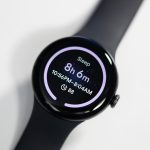Not too long ago, I wondered aloud why anyone should care about Google’s new Pixel Watch. And now, after nearly a week of using it, I’m still left wondering.
Unlike the excellent Pixel phones that have carved out a niche for themselves with some of the best cameras in the game, the Pixel Watch doesn’t have much of an identity right now. This is an extremely basic (and also perfectly competent) smartwatch. It has seamless Fitbit integration for health and wellness tracking and can do all of the normal things you want from a smartwatch, like receiving phone calls and checking mobile notifications without looking at your phone.
All of that is fine, but none of it is remarkable. Unless you’re a huge fitness freak who also happens to be totally bought into Google’s hardware ecosystem, there’s not much of a hook to this $350 smartwatch ($400 if you want LTE) which launches on Oct. 13.
Yep, that’s a watch
Credit: Kyle Cobian/Mashable
Reviewing the Pixel Watch is a tremendous challenge for any writer because it’s difficult to describe the device without resorting to: “It sure looks like a watch.”
That’s the thing, though: It just looks like a watch!
For the Pixel Watch, Google went with a circular watch face, aligning the device with Android cohort the Samsung Galaxy Watch and contrasting it against the rectangular-shaped Apple Watch. It’s got a 44mm diameter with a rotating crown for scrolling through apps and notifications on one side and a small button that’s used for summoning a quick list of recent apps you’ve used just above it.
Aside from that, there are not many hardware features worth noting.
Google has a gang of watch bands you can buy, like a woven one or a metal links band coming next spring that costs $200. For reference, the Samsung Galaxy Watch 5, which is a full-on smartwatch and not just a watch band, starts at $280. Anyway, there’s a small button next to where the watch band connects with the watch face and holding that in will let you easily slide the watch band off to replace it.
Credit: Screenshot: Google
The initial Pixel Watch setup is a little time-consuming, but not overwhelmingly difficult.
You need to download the Pixel Watch app from the Play Store on your phone, make sure the watch is turned on and near an Android phone with the app open, and then follow the onscreen instructions. This mostly involves a lot of sitting and waiting for pairing to complete, though you’ll also be prompted to install any apps on your phone that happen to have corresponding Wear OS versions. From start to finish, it takes about 10 to 15 minutes to complete setup, assuming everything works properly.
For transparency’s sake, my Pixel Watch setup took much longer than that because the phone simply would not pair with the watch no matter what I did. I had to factory reset the watch before I’d even used it to fix that problem.
As for the Pixel Watch UI. it’s simple and clean. Swiping down pulls up the watch’s quick action menu, while swiping up shows all recent notifications. Swiping left and right navigates through customizable “tiles,” each one representing something like a step counter, a heart rate monitor, a weather readout, and a quick way to start exercise routines. These can be swapped in and out, or moved around within the Pixel Watch app, which is nice and handy. The same goes for watch faces, of which there are already dozens to choose from.
Credit: Alex Perry/Mashable
I just wish the Pixel Watch’s screen were bigger. Navigating the UI isn’t hard, but it’s a little tiresome thanks to the tiny form factor. You can only really read one notification at a time and even that depends on how much text is in said notification. Responding to messages via voice works OK, but trying to type anything on the Pixel Watch’s tiny keyboard is a fool’s errand.
At least it feels good to wear. I exclusively used a basic black leather watch band for my entire time with the Pixel Watch and I probably wouldn’t have it any other way. While the Pixel Watch is visually super nondescript, I did find it supremely comfortable to wear. I’ve always hated wearing anything on my wrist, but I was able to wear the Pixel Watch nearly 24/7 for four days (including while I slept) without any discomfort whatsoever.
Unfortunately, my lifestyle was not as compatible with the Pixel Watch as my wrist.
Fitbit friendly
Credit: Screenshot: Google
In one sense, the Pixel Watch feels like the culmination of Google’s Wear OS ambitions. It’s hardware married to software, both made by the same company, just like the Pixel phones. In another sense, it’s basically just a Fitbit with another name. Makes sense, considering Google bought Fitbit a few years back.
Every Pixel Watch comes with six free months of Fitbit Premium, which normally costs $10/mo. That service gets you a bunch of bells and whistles like detailed breakdowns of your sleep and stress management statistics, exclusive exercise challenges and mindfulness sessions. You’re actually prompted to install the Fitbit app during the initial setup of the Pixel Watch, making the connection that much more obvious.
Credit: Screenshot: Google
This wound up being the least appealing aspect of the Pixel Watch to me, though that’s mostly a matter of lifestyle preferences. I’m not an avid exerciser, so opening a Fitbit app that contains a bunch of complex-looking, weird metrics like “Zone Minutes” and “Daily Readiness Score” immediately turned me away from the whole thing. By default, the watch even notifies you once every hour to get some exercise, which I found more annoying than helpful.
I’m not going to ding the Pixel Watch for being so entwined with Fitbit. It makes sense from a Google corporate synergy perspective and Fitbit is one of the biggest names in digital fitness tracking. Chances are, this will appeal to workout warriors in a way that it didn’t appeal to me. Just know going into the Pixel Watch experience that you may need to shell out $10 every month to get the most out of it.
Doing the bare minimum
The Pixel Watch’s biggest failure is arguably that it just doesn’t do much to stand out if you’re not into the whole Fitbit thing. It’s not like the Pixel phone line, which has become arguably the gold standard among Android handsets thanks to great performance and better cameras. This is a very standard smartwatch with a conventional feature set. Most of it works just fine, but none of it made me think: “Man, I need to get one of these!”
You can activate Google Assistant with a quick “Hey Google” to set alarms, make reminders, and do whatever else you’d normally do with Google Assistant. Google Maps support means you can navigate without looking at a phone, while YouTube Music and Spotify let you stream all your favorite jams straight from your wrist. You can even use it as a viewfinder for your Pixel phone’s camera. Though with such a small, circular screen, I can’t imagine why anyone would do this. If you’re already holding a Pixel phone, just use that beautiful display like it was intended to be used instead.
Credit: Kyle Cobian/Mashable
Naturally, it also acts as a step counter and heart rate monitor, both of which feed into the Fitbit app but also thankfully work as standalone features. I personally chose a watch face that showed the time, the date, my step count, and my heart rate. Those are the only things the Pixel Watch tracks that I really needed to know, anyway.
Unlike the Galaxy Watch 5 and Apple Watch Series 8, the Pixel Watch doesn’t appear to have a skin temperature sensor. Apple in particular has used that for helpful fertility tracking tools, so it’s a bit of a bummer to see Google behind the ball on this.
There is an electrocardiogram (or ECG) tool on Pixel Watch, but I had some trouble with it. The idea is to detect abnormal heart rhythm, so you sit your watch hand on a flat surface for 30 seconds with a finger placed gently on the crown. The first two or three times I tried this, however, the app would lock up with one second left and I’d have to start the test over. It worked eventually, but it was a buggy experience overall.
Credit: Alex Perry/Mashable
One of the more unique Google-y features on the Pixel Watch is the ability to control Google Nest smart home products directly from the watch face. I do not own any smart home devices because I value my privacy, so I couldn’t test this. But it’s there if you’re a big-time Nest-head.
Battery-wise, you’d hope that the Pixel Watch would at least do something to set itself apart from the smartwatch pack, but nope, not really. It lasts a little less than 24 hours in my experience, so you’ll need to place it on the included USB-C charging dongle at least once a day. I’ve had to do this before bed at least once because it recommends having at least 30 percent battery for sleep tracking.
Given all this, there just isn’t much inherent value to the Pixel Watch, especially compared to the competition. Samsung’s Galaxy Watch 5 can also do most of these things for $70 less. Sure, the Pixel Watch integrates more cleanly into Google’s ecosystem, but is that really worth an extra $70?
Merely a first step
Taken in totality, the Pixel Watch’s feature set and hardware design make for a passable first try, but little beyond that. The screen is too small to be useful for any applications that require input beyond a glance and the watch itself doesn’t even look cool enough to stand out as a status symbol.
It does most of what you’d expect out of a modern smartwatch, but little else.
Honestly, the most relevant thing I can say about the Pixel Watch is that I wore it for four days straight and barely thought about it. Sometimes, I’d check a notification or glance at the time, but those are things I can already do better on a phone screen. Sure, it could tell me how I slept, but I already know how well I sleep. Put simply, my life was not improved in any meaningful way by wearing the Pixel Watch.
As we say in sports fandom, there’s always next year.







